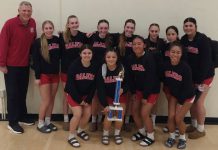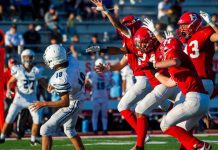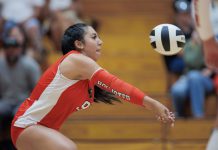Technological advances have made the old ‘Astroturf’ cheaper,
better-looking and possibly even safer
… so local high schools are scrambling to install synthetic
fields. Part I of a two-part report on the new generation of
artificial playing surfaces.
They’re popping up like blades of grass after a big rain, these new all-weather, synthetic turf fields. Polyethylene grass, that is.
It used to be that only professional sports teams could afford artificial turf. Then, as they became a bit cheaper, major colleges started to install artificial fields.
Now, junior colleges and high schools are in the market for artificial turf. Technological advances have improved the look, durability and, most say, the safety of the fake stuff. But most crucially, synthetic fields are now a whole lot cheaper to install and maintain.
In the area, high schools from San Jose to Salinas already have synthetic turf fields, or are in the process of installing them. Locally, Gilroy High’s school district board of trustees recently approved a sweeping facilities improvement plan that includes a synthetic turf field and San Benito High has been considering such a project for a few years. Meanwhile, Live Oak and Sobrato in Morgan Hill look on with envy, and a little regret, after installing high maintenance natural grass fields recently.
According to Gilroy Unified School District Superintendent Edwin Diaz, the school board’s unanimous vote to approve a synthetic turf field as part of a $175 million package on Dec. 16 reflected the school district’s commitment to a top-notch upgrade of its sports facilities.
“We wanted something that is state-of-the-art, that can absorb high usage and is the safest we could find,” Diaz said. “The (synthetic turf) technology has improved dramatically.”
For about $1.4 million, Gilroy High will get both the synthetic turf field and an all-weather track (at about $600,000 each) at Mustang Stadium. Diaz said the new field surface, manufactured by a company called SprintTurf, is the newest generation of synthetic turf. It includes thousands of blades of polyethylene “grass” anchored in a base of granulated rubber, supported by an extensive drainage and cooling system beneath the turf surface.
The turf, which includes a standard eight-year warranty, is designed to simulate the softness of natural grass and dirt. It is generally recognized as being as safe, and some say even safer, than natural grass.
At Valley Christian and Milpitas, both of which have installed synthetic turf on their schools’ football/soccer fields, as well as on their baseball and softball fields, athletic directors Eric Scharrenburg and Jeff Lamb say they have actually seen a reduced incidence of injury during play.
At Gilroy High, the new synthetic turf field will not only be durable enough to accommodate the high school’s football needs, it will also be used by a range of other sports and activities, including soccer, field hockey and band practice. Gavilan College and Pop Warner football teams may also use the field on occasion.
Non-Mustang football use of the current natural grass field is limited or banned entirely, especially during the rainy months due to the potential for damage.
The new synthetic turf, on the other hand, will even be able to accommodate the needs of a planned new high school scheduled to open in 2008, which would play its football games and perhaps other sports at Mustang Stadium.
GHS Athletic Director Jack Daley said the new surface will be a boon for the high school’s sports programs.
“It becomes a benefit in the sense of pride,” Daley said. “It gives the community more access. And, it allows more school teams to use the facility.”
Mustang football head coach Darren Yafai couldn’t be more pleased with the prospect of playing and practicing on the new synthetic turf.
“I think it’s a huge benefit for our school,” Yafai said. “We have a nice stadium as it is but this will make it that much nicer.”
High school officials are hoping to get the project to bid as soon as possible, and the new field and track could be ready as soon as June of 2005.
Diaz said installing both the new field and the new track at the same time will save the district money by reducing related contingency costs. The superindent also noted that there will be vastly reduced maintenance and upkeep costs with the elimination of the watering, striping, mowing, re-seeding and re-sodding that can run anywhere from $30,000 to $60,000 per year.
Daley said those savings, realized over a 10-year period, will make the cost of installing a synthetic turf field “a wash.” In addition, the school district will save money because it won’t have to pony up the cost of a new stadium for the planned new high school.
Lastly, the school won’t have to deal with the problems other schools, specifically Live Oak, have had with installing or re-doing their grass fields.
“We just don’t have the maintenance staff to maintain the (grass) fields,” Daley said. “I think we’ll see the benefit of not having to deal with a grass field.”
Diaz and Daley said they did extensive research regarding synthetic turf fields, including trips to Bay Area schools such as Valley Christian, Milpitas and Piedmont Hills which have the turf, as well as to the University of Southern California, where the newest generation of the turf has been installed.
They did admit that the turf is so new that there is no hard data on what happens after the warranty expires and fields begin to show wear.
However, most believe the fields can be renovated by patching or re-doing portions of the turf that begin to show the most wear – a far cheaper alternative to replacing the entire surface. Even if the entire surface has to be repaired, the cost is much less than the initial installation because about half that cost includes the installation of the substrata, which includes the drainage and cooling systems. Those are expected to last much longer than the surface itself.
At San Benito High, school officials are considering a synthetic turf field and all-weather track as part of a much smaller facilities improvement plan.
According to Superintendent Jean Burns-Slater, school officials have been discussing since May whether to use about about $680,000 in one-time savings as seed money for the proposed turf and track project. She said since the entire project would end up costing more than $1.3 million, the school would have to raise the additional amount.
Burns-Slater said there is plenty of support for the proposal but pointed out that there are other priorities on the school district’s plate, including needed educational facilities. But she did highlight as positives the savings generated by reduced maintenance and upkeep costs, the improved safety aspect and the increased use associated with a synthetic turf field.
“Everyone (on the school board) is very much in support of (a synthetic turf field),” she said. “It’s a question of whether to install a track and a field or a library and media center.”
But San Benito athletic director Tod Thatcher said he believes the track and field project stands little, if any, chance of being greenlighted. Thatcher said Physical Education Department chair and former AD Randy Logue proposed the synthetic track a year ago after composing an extensive study on the subject but there has been virtually no movement towards implementing Logue’s recommendations.
“Randy brought this up three years ago and we still don’t have a field,” Thatcher said, questioning the school board’s commitment to the proposal. “At this point, there is zero chance.”
Thatcher said the high school’s current natural grass football field “doesn’t last through the football season. By Game 8, it’s pretty much a mess. We don’t even practice on the field. With a new (synthetic turf) field, we could practice on it, we could have markings, and a lot of other teams could use it, too. It would be a huge benefit for our school.”
Meanwhile, Live Oak and Sobrato school officials said they would have loved to install synthetic turf at their schools, but when the Morgan Hill School District Board of Tustees was considering what kind of turf to install, the cost was prohibitive.
Current Sobrato athletic director Dennis Martin, who was the Live Oak AD during the planning stages of the school district’s massive facilities improvement project, said school officials decided they couldn’t afford the $1 million cost of synthetic turf, despite a recommendation in favor by contractor Beals Sport.
“When we looked at it for Live Oak, (the cost) was way out of sight,” Martin said. “Since then, the prices have dropped way down. Now they’re affordable because everybody’s putting them in. It’s supply and demand.”
Unfortunately for Live Oak, it ended up with a natural grass field that experienced a multitude of problems, including patchy spots and sinkholes that made it unusable for more than six months. Even now, the field isn’t being used regularly by anyone but the football team and only for games, and it requires considerable maintenance.
Earlier this year, school board trustee Mike Hickey said district officials should have given a synthetic turf field more thought and he would still like to see one installed at either Live Oak or Sobrato.
“In hindsight, we definitely should have put in an artificial field,” Hickey said.
With foresight, it may be only a matter of time before nearly all area schools do just that.









